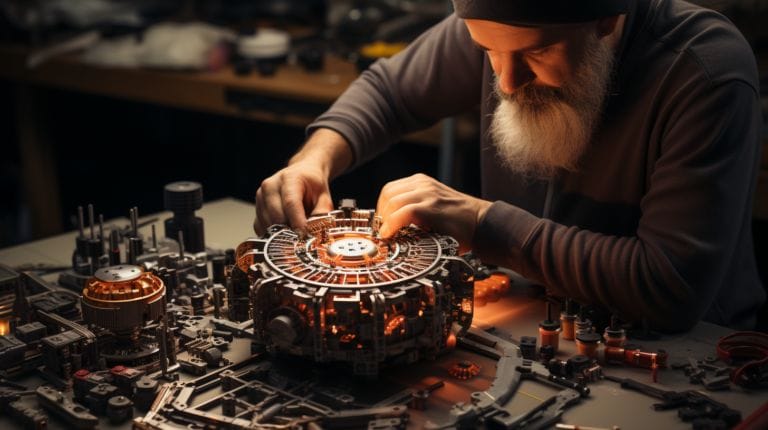Wireless Electricity How Does It Work? An In-depth Overview
As we explore the fascinating world of wireless electricity, we find ourselves intrigued by the principles of electromagnetism that allow energy to transfer between coils without physical connectors. This technology hinges on key components like transmitters, receivers, and resonators, which work together to create efficient power transfer over distances. Understanding the science behind inductive coupling and resonance is essential to appreciating how this innovation could reshape our daily lives.
But how exactly do these components interact to facilitate seamless energy transfer? Let’s uncover the mechanics and potential of wireless electricity together.
Key Takeaways
- Wireless electricity transfers energy via electromagnetic fields between transmitter and receiver coils without physical connectors.
- Alternating current through the transmitter coil creates a dynamic magnetic field, inducing voltage in the receiver coil.
- Resonance tuning of transmitter and receiver coils maximizes power transfer efficiency and reduces energy loss.
- Inductive coupling is the primary method for wireless charging of devices like smartphones and electric vehicles.
- Future advancements aim for efficient long-distance energy transfer and integration into infrastructure for seamless wireless power.
Understanding the Concept of Wireless Electricity

Wireless electricity, or wireless power transmission, allows us to transfer energy without the need for physical connectors. This concept is already reshaping how we power our devices, making technology more seamless and efficient.
Wireless electricity relies on the principles of electromagnetism. A current flowing through a coil generates an electromagnetic field, which can then transfer energy to another coil positioned within its range. This process is what powers devices wirelessly.
Imagine charging our gadgets without plugging them in—this is the magic of wireless power transmission. It eliminates the clutter of cables and opens up new possibilities for how we design and interact with technology. Wireless electricity is not only a convenience, but it’s also a step towards a more innovative and interconnected world.
Key Devices and Components Involved in Wireless Electricity

To appreciate the marvel of wireless electricity, we need to understand the key devices and components that make this technology possible. Transmitters generate the electromagnetic field, while receivers capture this energy and convert it back into electrical power.
Antennas facilitate the efficient transmission and reception of electromagnetic waves. Optimizing the design of these antennas can enhance the range and efficiency of wireless power systems.
Resonators are specialized circuits designed to oscillate at specific frequencies, ensuring that the energy transfer between the transmitter and receiver is maximized.
Converters transform the captured electromagnetic energy into a form that can be used by various devices. These components—transmitters, receivers, antennas, resonators, and converters—work harmoniously to make wireless electricity a reality.
The Science of Inductive Coupling in Wireless Electricity

Inductive coupling harnesses the power of magnetic fields to transfer energy wirelessly between devices. This method relies on two coils: a transmitter and a receiver. When an alternating current flows through the transmitter coil, it creates a dynamic magnetic field. This magnetic field induces a voltage in the receiver coil, enabling power transfer without any physical connection.
The efficiency of power transfer largely depends on the alignment and proximity of these coils. Even at small distances, it’s possible to achieve effective wireless electricity transmission.
Inductive coupling is already transforming our lives, with wireless charging for smartphones and electric vehicles being the most prominent examples. It’s also making strides in medical devices, allowing for safer and more efficient power sources for implants and other critical equipment.
The Role of Resonance in Efficient Wireless Power Transfer

Resonance occurs when the transmitter and receiver are tuned to the same frequency, allowing them to exchange energy more effectively. By matching the frequency of both coils, we reduce energy loss and boost power transfer efficiency.
Resonance enables us to transmit power over greater distances with minimal loss. Traditional induction methods can be inefficient over long ranges due to energy dissipating into the environment. However, when resonance is applied, it creates a more focused and efficient transfer of energy.
Implementing resonance in wireless technologies has opened new avenues for innovation. From charging electric vehicles without physical connections to powering medical implants inside the human body, resonance is revolutionizing how we think about energy transfer.
Future of Wireless Technology Powered by Wireless Electricity

The future of wireless technology promises to revolutionize countless aspects of our daily lives. Imagine a world where our electric vehicles charge seamlessly as they drive over embedded transmitting coils in the road. Our homes and workplaces could soon be filled with devices that draw power wirelessly, eliminating the wires and plugs that currently clutter our spaces.
However, these advancements come with challenges. Ensuring efficient energy transfer over longer distances and through various materials requires continued innovation. But the potential solutions are just as exciting. Advances in materials science and resonant inductive coupling could overcome these obstacles, making wireless electricity a staple of modern life.
Conclusion
To sum up, we’ve explored how wireless electricity works, from the core principles of electromagnetism to the essential components like transmitters and resonators.
We’ve delved into inductive coupling and the significant role of resonance in making power transfer efficient.
Looking forward, it’s evident that wireless electricity holds immense potential to reshape our lives, making energy transfer more seamless and innovative than ever before.
We can’t wait to see what’s next!
Frequently Asked Questions
What is wireless electricity?
Wireless electricity refers to the transmission of electrical power from a power source to an electrical device without the need for physical connections like cords or wires.
How does wireless electricity work?
Wireless electricity works by using methods such as electromagnetic induction or radio waves to transfer power from a power source to an electrical coil of wire in a receiver device.
What are the different methods for wireless power transfer?
Several methods for wireless power transfer include:
- Inductive Coupling: Uses electromagnetic fields to transfer energy between two coils.
- Resonance: Uses resonant inductive coupling to transfer power over longer distances with high efficiency.
- Microwave Transmission: Transfers power through microwave frequencies.
- Laser Beaming: Transfers power via laser beams.
What are the benefits of using wireless energy?
Wireless energy technology is convenient, sustainable, and eliminates the need for multiple chargers and cords for electronic devices like smartphones, tablets, and wearables.
In what devices is wireless electricity commonly used?
Wireless electricity is commonly used in handheld devices like smartphones, electric toothbrushes, and medical devices like pacemakers.







